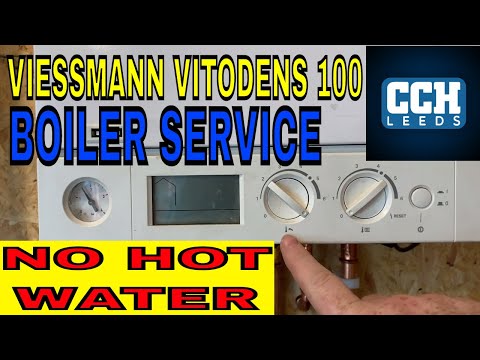Combi Boiler – No Hot Water. Boiler Service. Viessmann Boiler. Cleaning a plate to plate heat exchanger. no hot water on a Viessmann Vitodens 100. This boiler is a 35 kilowatt boiler, so I’m going to go through some of the basic things to check. Also, this boiler, the water is fluctuating hot and cold. It goes up to temperature, so I’ll show you that, and then I’ll show you how to repair it as well.
First of all, let’s have a quick look at the boiler. This is the Vitodens 100 WB1C, and it’s a 35 kilowatt boiler. We would expect to get around 14 litres a minute from this at 35-degree rise. I haven’t turned the power on yet on this, but obviously we’d check the power was on. That’s the hot water selector. We would turn that up, make sure that’s up onto full, and then we’ll turn the boiler on. Then what I’m going to do, before we even take the case off, and before we look inside the boiler, we’ll go run the hot water tap, and we’ll check the flow rate just to make sure that it’s not running too quick through the boiler. So we’ll check that now.
The importance of checking this is if you’ve got too much flow going through the boiler, then the water will be cooler. It can only raise a temperature by 35 degrees, and that’s at 14 litres per minute. We can see that clearly, it is about 14 litres a minute. We’ll leave that running now, and then we’ll go and have a look inside at the boiler temperature.
We’ve turned the hot water on now, and it’s just going up to full. We would expect this normally to settle around 62 to maybe 67-ish, so maybe about 65 degrees we’d normally expect this to settle at. If it goes above that, then we would suspect it could have a problem with a plate heat exchanger, so we’ll see what happens here now.
We can see it’s going above what we’d expect it to be. This is getting a lot higher now than we would expect. This would indicate to me, or it would give me an idea that we’ve got a blocked or a partially blocked plate heat exchanger. Now what we’ll do, we’ll have a look inside, just where it’s safe. This shuts off, but then we’ll have a look inside and we’ll strip it down. We’ll take the plate heat exchanger out, we’ll clean it out, and then we’ll put it all back together. Then we’ll do this again, and we’ll see what difference we have. We can see that now the burner’s just gone down. If we measured temperature of water now, we’d find that the hot water’s probably not that hot because it’s going on and off. It’s going up to temperature, shutting off. You can hear it, it’s gone down now. That’s the reason for the problem with this boiler. Let’s strip it down now, and we’ll have a look.
As always, if you’re going to take the combustion cover off a boiler, make sure you’re gas safe registered, or get somebody who’s gas safe registered to do it for you. You’ve got two screws under here. First of all, you turn the power off, and then we would do all our safety checks. We’d go under these two screws and then we’ll just lift the cover off.
I’ve undone the screws below, and then the case just lifts off. As I say, this has got a seal on here, so you must be gas safe registered if you’re going to work on this boiler. Let’s have a look inside, and we’ll have a closer look. If you want to get to the plate heat exchanger, just lift these flaps down. Then the plate heat exchanger is right at the back there. To make it easier, you’re going to take the burner out. Now, this seems to say that it’s been serviced 2017, which normally when people write stuff like this on, it means it’s been fully stripped down. But when I look at the gas pipe here, I can see that it’s still got the seal on there. So I would suspect that when we lift this out in a minute, this has never been serviced. We’ll have a look, and we’ll see. I’ve connected the pump onto this now. I’m just going to pump it out. There’s no pressure on this at all. Obviously, it’s never been checked … well, it haven’t because it was sealed. So I’m going to pump this up now. There’s different calculations with this, depending on the system. I normally top them up the about one bar, so on that now, it’s just over one bar. As I undo it off there, the pressure will drop a little bit.
I’ve just connected the expansion vessel back in now. As I said, very easy, just a nut up on top. One good thing about this boiler is everything is really easy to work on. Then the pipe, I’ve connected that pipe back on there, and then that just connects in. This just connects in back down there. You just push it in, and then you’ve got a little clip. Then that just clips in there, nice and easy.
Video







